

Do you believe in fate? I’ve gotten to the point where I do. Say I’m working on a book based on a certain subject. Well, suddenly I can’t pick up The New York Times or any newspaper or magazine without the very subject or background falling into my lap. Yes, just like magic. This has happened to me time and again.
Therefore I have every reason to believe that fate made me pick up the Travel Section of The New York Times that fateful Sunday in October, 2003. I usually skip the Sunday Times—it’s the household copy, and for me, there’s just too much to read. I mean, you could spend all week reading that one issue, it’s that fat. Then what made me pick up the Times that particular day (and the Travel Section yet) and chance upon but an article about Last Minute Travel Deals? Fate, obviously. It had to be.
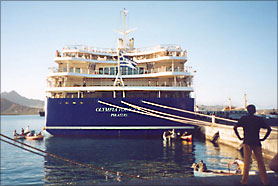
For there it was in black and white: 18-Night Transatlantic Cruise on the Royal Olympia Voyager—with prices so ridiculously low that you can’t eat dinner at a decent restaurant in any major city for a week, let alone be pampered, travel, and fed for 18 nights. It sounded too good to be true, but for once that adage about “If it sounds too good to be true, it probably isn’t,” didn’t apply. Because I called my travel agent and sure enough, it was for real.
The cruise was to begin in Athens, Greece (which I’d just left at the end of September!), and meanwhile I had The Parisian Affair‘s deadline to meet. But who could possibly resist such a deal—and with more stops than any other cruise ship’s I’d ever seen. Imagine—the Mediterranean, semi-tropical and tropical islands in the Atlantic, the Amazon River, plus the Caribbean? Yowsa!
My Favorite Greeks:

Miss Vicky, the matriarch of the family-run Acropolis House Hotel, who reads all of my Greek language editions.

Roula (middle) and innkeeper Panos (right) with Nick (see The Story of Judith Gould). In front of the Acropolis House Hotel where I always stay when in Athens.
|
Quite honestly, I’ve always resisted cruise ships, preferring the privacy of even the smallest chartered sail or motor yacht, but this itinerary swayed me. So did the size of the ship—small and intimate by today’s standards. At just 25,000 tons, and a mere capacity of 836 passengers and 360 in crew, I wouldn’t feel like an ant among thousands of other passengers. Plus, since there were outlets for both 110V and 220V, I could use my laptop and work on The Parisian Affair every day and thus meet my deadline! To paraphrase Jack Lord on Hawaii Five-O, I didn’t hesitate and told my travel agent, “Book it, Peg-o.”
Peggy, with a voice like sandpaper and about as much charm as crushed glass, did.
Presto! I was back in Athens. Though Peggy booked the cut-rate airfare (a super deal!), I did indulge in what travel professionals call “a tour deviation” in order to spend two days in Athens to decompress. However, I didn’t let Peggy book my hotel—and for a good reason.
For years now, I’ve always stayed at the same small, very inexpensive, family-run hotel practically at the foot of the Acropolis. In fact, the hotel I used in Dreamboat is based on that very one, and even Constantine, the hotel owner in Dreamboat, is based on a real-life person—Panos, one of my favorite people in the world. (Pssst! I based the Doric House hotel in The Greek Villa on that same hotel—and shamelessly populated it with the real-life Panos and his delightful mother, Miss Vicky, who always welcome me with open arms.
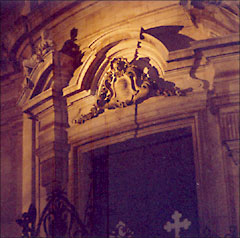
Two afternoons later, I boarded the Royal Olympia Voyager, which was to morph into Dreamboat‘s fictional counterpart, Sea Nymph. I had expected either a no-frills ship or one of those over-decorated, over-gilded Vegas-like hotels, only on a much smaller scale.
Surprise, surprise. I couldn’t have imagined a more tastefully decorated cruise ship. Its modern simplicity and stylishness suited me to a T. My junior suite had a picture window and more closet space than a Manhattan studio. The main staircase was lined with frosted glass panels sand-blasted with Cavafy’s poem, The Road to Ithaca, in both English and Greek—a detail which I borrowed for the fictional Dreamboat (just as I borrowed the deck plans and other such elements). Best of all, Royal Olympia Voyager had just two tiny boutiques which sold mostly necessities like film and razor blades, plus there was a small gym and a spa. The bottom line: you weren’t tempted to spend much on extras onboard. I also liked the one-class system which made all facilities available to everyone, and the choice of two dining rooms, one rather more formal and fancy, the other a casual buffet—and all food (except alcoholic beverages) was included in the fare.


Twilight came, and off we sailed. The sea was smooth, and other than needing a light jacket, the weather was perfect. First stop the following morning: Catania, Sicily. My tour to travel up to the crater of Mount Etna, Europe’s liveliest volcano, was foiled by fog, but Catania was gorgeously baroque and to die for, the shopping terrific, and I could have stayed in nearby picturesque Taormina for the rest of my life. But there was so much more to come. The next morning, we arrived in Naples, and took a tour to Pompeii. (I swear you can still smell the ashes. Well, Vesuvius isn’t exactly dormant, either, and tends to huff and puff every now and then, and rises in the distance like a benign yet every threatening presence.)
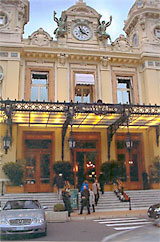
Chips Ahoy: The casino in Monte Carlo
|
So: Athens, Sicily, and Naples were behind us. Next stop: Genoa. There, a day-long bus tour along the Ligurian coast and the Italian and French Rivieras proved a must. Can you imagine—San Remo, Monte Carlo, and Nice all in one day? It was exhilarating and exhausting, and yours truly slept very well that night, and could dream of hanging out on the Riviera forever.
You’d have thought that was a cruise all by itself—right? Wrong! Not on the good ship Royal Olympia Voyager. The cruise had barely begun—and we were going Transatlantic, remember? So when the 5th day came we found ourselves in Barcelona. What a breathtaking city, and worth a much longer return visit. Then out we sailed through the straits of Gibraltar and into the Atlantic, where a day at sea was a nice respite for sensory overload.
Then came Tenerife in the Canary Islands. Having made friends with the loveliest couple from Canada, we walked the sidewalks of Santa Cruz de Tenerife, sat in tropical parks, and sipped wine and coffee outdoors. Our 9th day found us in the Cape Verde Islands, off the coast of Senegal, Africa. Unfortunately, the term “verde,” which means “green,” no longer applies. The mountains have been denuded over the centuries and are as stark and dramatic as a lunar landscape. The most amazing thing? An old-fashioned bottle of Coca Cola cost the equivalent of a nickel!

Naturally, there was the traditional Equator crossing, with the usual high-jinks and one of the passengers playing Neptune. Since the Royal Olympia Voyager was designed and built for speed, it only took two days to cross the Atlantic to the mouth of the Amazon. Most cruise ships take twice that long, but a visit to the bridge (as well as a private dinner with the captain) resulted in the most amazing information—grist for the fiction mill! How else would I have discovered that the real-life Dreamboat had a steady, incredible cruising speed of 28 knots? Sure, there are other ships that can reach that speed, like the QE II and the QM II, but they would vibrate to pieces if they tried to hold that speed constantly. A real plus to me—and vital to the plot of Dreamboat‘s Sea Nymph—was that at that speed the ship, while on automatic pilot, was incapable of changing course automatically to avoid crashing into anything in its way. The only way to change course going that fast had to be done manually.
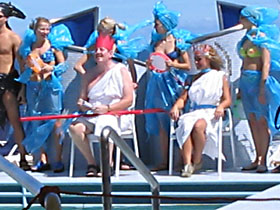 |
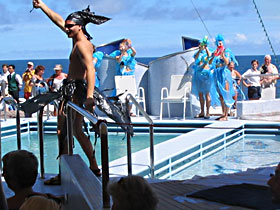 |
First-timers get the traditional Neptune treatment.
But the highlight of the cruise were the friends I made onboard. (Some of us are still in contact, correspond regularly, and even visit one another!) Plus, I loved Happy Hour, having every meal served, never making a bed, and spending HOURS on the dance floor. Well, that’s one way to lose weight!
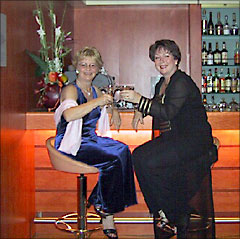
In Brazil, we docked in the Amazon at Belém, and took a city and jungle tour. It was fascinating but a bit spooky, since we could only visit certain areas patrolled by soldiers, and were accompanied at all times by an armed guard.
Our next stop as we headed north was the shark-infested Devil’s Island, of notorious French prison fame. Perhaps you saw the 1970s movie, Papillon, with Dustin Hoffman and Steve McQueen? Well, the Devil’s Island I saw was so utterly beautiful I didn’t want to leave! Worst of all, since I collect coffee mugs from everywhere I travel, the only mug I could find here was neither decorated with insects (which the prisoners apparently ate to supplement meager diets), nor prison bars and not even Dustin Hoffman, Steve McQueen, or the real Papillon. There was but one mug, period—and it features the French Guiana European Space Station! That’s because Devil’s Island is now used to track rockets and satellites launched by European countries from the nearby mainland.
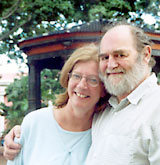
It Takes an Engineer: Tony (above
with Shelley) asked just the right
questions on a tour of the bridge—and that sealed Dreamboat’s climax.
|
The remainder of the 18-night cruise was a blur: Barbados, then Guadeloupe, which has such fine French colonial architecture, almost all of which needs restoration so badly, that it really should be on the most endangered world monuments list.
Our next stop was quite the opposite. During breakfast we docked in spic-and-span Nassau in the Bahamas. And the morning after that one, it was time to disembark at Port Everglades, Florida. Needless to say, I had the entire plot of Dreamboat already written in my head. It was difficult to say farewell to my real-life Dreamboat—and my new-found friends. It goes without saying, that a lot of my fellow passengers populate my fictional Sea Nymph.
For instance, the character of Monica Graf is based on a Viennese lady I met aboard, although the actual person was considerably older than my fictional Monica. But she had the same silvery-white dyed Medusa (or Phyllis Diller, take your pick) hairdo, and wore theatrical make-up, dressed in glittery clothes, whether it was day or night, and, always carried a huge gold handbag. She was not an author, however, as Monica Graf, but had been a personality on Austrian television.
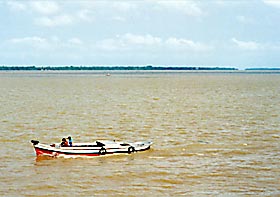 Old Man River: View of just one of the Amazon’s many
tributaries, this one at Belèm, Brazil.
|
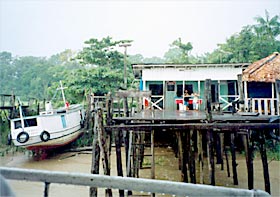 View to a Kill: One of these
backwaters in the Amazon inspired
a scene near the end of Dreamboat. |
Ditto my characters Mina and Rudi. They were a lovely couple in their forties and compatriots of the real-life Monica Graf’s. Ballroom dance afficionados, they waltzed and fox-trotted the nights away—every night without fail! And just as in Dreamboat, the real-life “Mina” often dressed in red ruffles, the same as I gave my own. Needless to say, while I’ve known more than my share of Jenny’s and Mark’s in my life—haven’t we all?—these characters are composites of several people I’ve run across over the years, and aren’t based on any one person in particular.
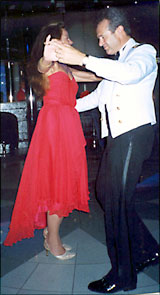
So. I’d managed to finish The Parisian Affair during the cruise, had an entire new plot in my head, as well as the entire supporting cast. Only one person gave me problems: who would be my heroine of Dreamboat? And as soon as I got back home, I didn’t have to look far. Crissy, who in the novel is a hair stylist/colorist, is based on the delightful young lady who colors my hair here at home. (Although I drive into New York City for haircuts, the real-life Crissy is the best colorist I’ve ever run across.) And it was there, in her salon while I was getting some highlights and she chatted about her humdrum life that—voila!—the one character missing from the Dreamboat plot—the heroine, fell right into place.
Another instance where real-life characters imitated fiction were two real-life friends, whom I don’t see often enough, but with whom I’d recently sailed the Aegean on a sailboat charter.
Many years ago (more than I wish to count), the wife and I were college roommates. Still single at the time, she decided to take a Caribbean cruise. And what should happen? She fell ill during the trip and went to see the ship’s doctor. I imagine you can guess the rest: they fell in love, got married, and are the proud parents of two gorgeous and talented grown children!
So there you have it, a glimpse into how real-life and fantasy were interwoven to create my newest novel, Dreamboat.
POSTSCRIPT: Sadly, soon after the Transatlantic voyage, the real Royal Olympia Voyager and the line’s other newest ships, were repossessed by the banks. The passengers and crew were forced to disembark in ports as varied as the Caribbean and South Africa, and word has it that the crews were flown back to Athens without getting paid—a terrible hardship for the many foreign workers aboard who sent their paychecks home to support families in places as far-flung as Bulgaria and the Philippines. How the passengers who were booked on those particular interrupted cruises, or who had booked future ones fared, I do not know. But it made for a bittersweet ending for so many marvelous memories.